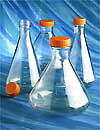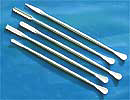


|

|
With a stactometere we take 1 cc of oleic acid and pour it in a graduated cylinder (sensitivity 1 cc) where we add 99cc of a volatile solvent: the hexane.

|
The hexane is poured directly from the bottle till the 90 cc sign is reached. After that we use a pipette (sensitivity 0,1 cc), which works through the capillarity phenomenon , until 100 cc are reached which a high precision. The choice of a volatile sulvent, in this case an hydrocarbure, is made because of its evaporation speed, the mixiture of hexane and oleic acid gives a 1% solution (in oleic acid volume) from which we take 1cc and pour it in a graduated cylinder of the same kind used before in this cylinder we pour again 99 cc of hexane this obtaining a 0,01% solution in oleic acid volume. These two operations allow to obtain a final solution of 100 cc where only 10-4 of oleic acid are dissolved in hexane. This is need because when we pour the solution into the basin filled with water, we must take care that the expanding stain of oleic acid doesn't touch the edges of the basinwhile forming the mono-molecular layer neede to perform the measure.
When we got the solution, we put it in a behute.

|
The basin filled with water is put over a graph paper and we wait until the froth caused by the pressure in the tap fades. At this point the water surface is covered with a fossil flour, called lycopodium, pouring it from a box at a given high so as to have it homogeneously scattered on the water surface, avoiding lump formation. The lycopodium is employed to create a coloured surface on the water as the oleic acid is colourless (as is the water) and it would be difficult to distinguish it from the water in the basin.

|
Now, with a pipette ( sensitivity 0,1 cc), 0,2 cc of the solution at 0,01% are taken and carefully poured into the basin . Here the volatile solvent evaporates leaving just the oleic acid which expands pulling the flour apart and forming an area not covered by lycopodium. When the stain doesn't expand any more, if it hasn't touched the edges of the basin, we can be reasonably sure that we have obtained a mono-molecular layer.

|
After waiting a few minutes we count the squares insite the stain and those crossed by the border of the same stain. These latters, once added to the inner squares, give the area of the stain approximated by excess. Of course the inner squares alone give the same area approximated by defect.We eventually compute the mean of these 2 measures and use this value as the approximate area covered by the oleic acid mono-molecular stain in the basin.